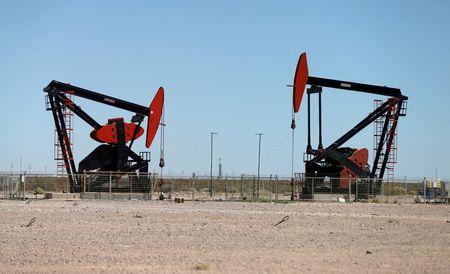
By Bozorgmehr Sharafedin
LONDON (Reuters) – Oil rose on Monday as a supply shortage and political tensions in Eastern Europe and the Middle East put prices on track for their biggest monthly gain in almost a year.
Brent crude had risen 87 cents, or 1%, to $90.90 a barrel by 1228 GMT. The front-month contract for March delivery expires later in the day. The most-active Brent contract, for April delivery, was trading at $89.03, up 51 cents, or 0.6%.
U.S. West Texas Intermediate crude rose 47 cents, or 0.5%, to $87.29 a barrel.
The benchmarks recorded their highest levels since October 2014 on Friday, $91.70 and $88.84, respectively, and their sixth straight weekly gain. They were headed for about 17% gains this month, the most since February 2021.
“Today it is above all the concerns about supply outages in connection with the Ukraine crisis that keep pushing prices ever further up,” said Commerzbank commodities analyst Carsten Fritsch.
The head of NATO said on Sunday that Europe needed to diversify its energy supplies as Britain warned it was “highly likely” that Russia was looking to invade Ukraine.
UBS analyst Giovanni Staunovo said “ongoing geopolitical tensions, more European countries planning to lift Covid related restrictions and renewed supply disruptions in Ecuador are supporting oil prices at the start of the week.”
OCP Ecuador, the operator of the country’s privately held heavy crude pipeline, suspended pumping crude on Saturday as a preventative measure after it ruptured in the Amazon, and began cleaning and repairs.
The market is also on alert over the Middle East situation https://www.reuters.com/world/middle-east/yemens-houthis-say-disclose-details-new-military-operation-against-uae-tweet-2022-01-30 after the United Arab Emirates said it had intercepted a ballistic missile fired by Yemen’s Houthi as the Gulf state hosted Israel’s President Isaac Herzog in a first such visit.
For oil prices, bullish sentiment will likely prevail this week, analysts said, with an expectation that OPEC+ will keep to its existing policy of gradual production increases.
Major producers in the Organization of the Petroleum Exporting Countries (OPEC) and allies led by Russia, collectively known as OPEC+, have raised their output target each month since August by 400,000 barrels per day (bpd).
At its Feb. 2 meeting, OPEC+ is likely to stick with a planned rise in its oil output target for March, several OPEC+ sources told Reuters.
Reuters survey of 43 economists and analysts forecast Brent would average $79.16 a barrel this year, a notable increase from December’s $73.57 consensus. U.S. crude was forecast to average $76.23 in 2022, versus the $71.38 forecast last month.
The oil forward curves were in deep backwardation, a market structure that encourages traders to release oil from storage and sell it promptly.
The six-month spread between Brent for March delivery versus September delivery was $6.75 on Friday, the steepest since 2013. At that time, oil prices were above $100 a barrel, a level analysts predict could be seen again this year as demand outstrips supply.
(Reporting by Bozorgmehr Sharafedin in London, additional reporting by by Yuka Obayashi and Mohi Narayan in Tokyo; Editing by Himani Sarkar, Kirsten Donovan and Louise Heavens)

